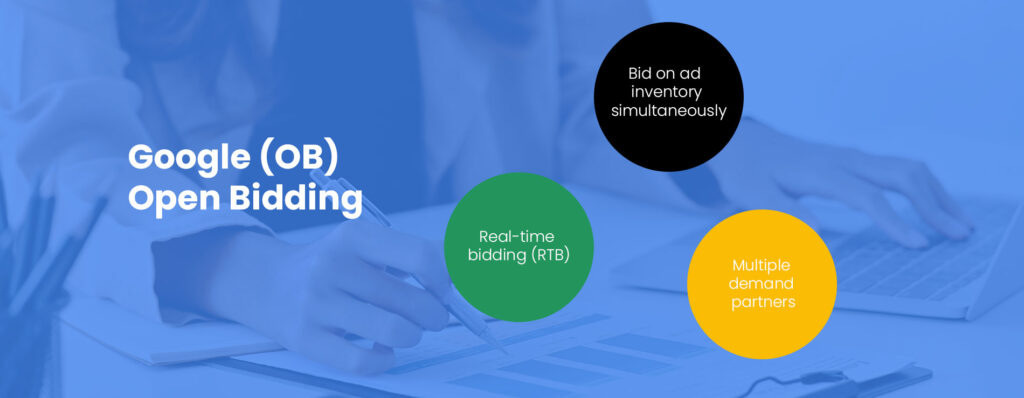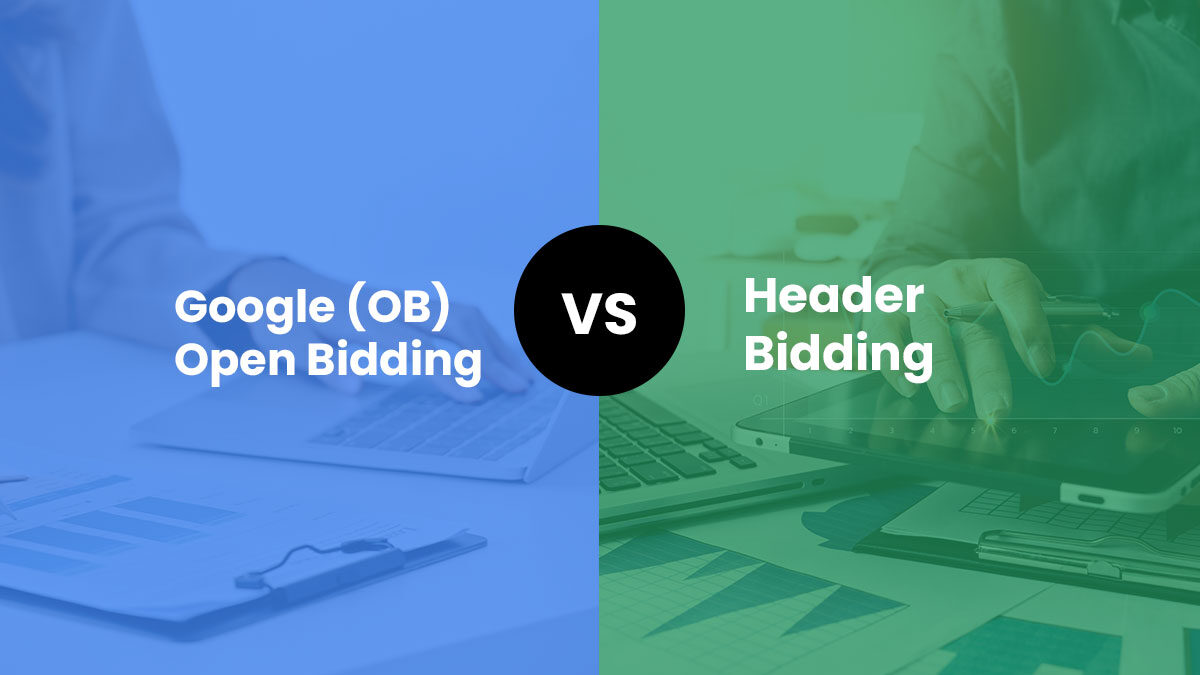Google Open Bidding (OB) and Header Bidding are two different methods of ad monetization that publishers can use to maximize their ad revenue. Both methods have their own advantages and disadvantages but the best way is using them parallel and let them compete with each other to increase your demand and the competition. In this blog post, we will take a closer look at both methods and compare them to help you make an informed decision.

Google Open Bidding
Google Open Bidding (OB) is an ad monetization solution offered by Google that allows publishers to run simultaneous auctions for ad inventory across multiple demand sources, including Google AdX, other ad exchanges, and directly integrated demand partners. With Google OB, the publisher sends the ad request to Google Ad Manager (GAM), and GAM sends the request to all the connected demand sources in parallel. The highest bidder wins the auction and the ad is served to the user.
To expand further, Google Open Bidding (OB) is a programmatic advertising solution that allows publishers to run simultaneous auctions for ad inventory across multiple demand sources. This method of ad monetization is based on real-time bidding (RTB) and enables publishers to access a wider pool of demand sources, including Google AdX, other ad exchanges, and directly integrated demand partners.
When a user loads a web page, the publisher sends an ad request to Google Ad Manager (GAM), which then sends the request to all the connected demand sources in parallel. This process allows all the demand sources to bid on the ad inventory in real-time. The highest bidder wins the auction and the ad is served to the user. This process allows publishers to increase their ad revenue by accessing a larger pool of demand sources and by ensuring that the ad inventory is sold at the highest possible price.
One of the main advantages of using Google OB is that it can help publishers increase their ad revenue. By accessing a larger pool of demand sources without direct contact with demand partners, publishers can potentially get higher bid prices for their ad inventory. Also, Google OB enables a faster monetization process as the auction process is all managed by the Ad Manager.
However, Google OB also comes with some drawbacks. One of the main disadvantages is that publishers have limited control over the auction and how the ads are served. The decisions regarding the auction and ad serving are made by Google Ad Manager. This can limit the publishers’ ability to customize the monetization process to suit their specific needs and goals. Also, the inventory available for auction through Google OB is limited to the inventory available on Google Ad Manager and demand partners that are integrated with it, so the pool of demand sources is not as wide as Header Bidding.

Header Bidding
Header Bidding, on the other hand, is a client-side method of ad monetization that allows publishers to run simultaneous auctions for ad inventory across multiple demand sources directly on the web page. The ad request is sent to all the demand partners at the same time, and the highest bidder wins the auction. With Header Bidding, the publisher has more control over the auction and how the ads are served, as all the decisions are made on the publisher’s website. However, one of the main drawbacks of Header Bidding is that it can increase the load time of the website, as all the demand partners need to be contacted before the ad can be served.
Header Bidding is a programmatic advertising solution that enables publishers to run simultaneous auctions for ad inventory across multiple demand partners directly on their website. This method is executed client-side, meaning that the code responsible for it is executed on the user’s browser, instead of on a server. This allows the publisher to have more control over the auction process, as all the decisions are made on the publisher’s website.
When a user loads a web page, the publisher sends an ad request to all the demand partners that are integrated with their website at the same time. This allows all the demand partners to bid on the ad inventory in real-time, which can increase the chances of getting the highest bid for the ad inventory.
One of the main advantages of using Header Bidding is that it allows publishers to have more control over the auction process, as all the decisions are made on the publisher’s website, This means that publishers can tailor the monetization process to their specific needs and goals. Furthermore, Header Bidding allows for a wider pool of demand partners, including smaller, specialized exchanges that may not be part of Google Ad Manager.
However, one of the main drawbacks of Header Bidding is that it can increase the load time of the website. As all the demand partners need to be contacted before the ad can be served, this can increase the time it takes for the web page to load for the user. This can negatively impact the user experience and may lead to users leaving the site, which can reduce revenue.
In conclusion
Google OB and Header Bidding are ad monetization methods that allow publishers to maximize their ad revenue by running simultaneous auctions for ad inventory across multiple demand sources. The choice of which method to use depends on the specific needs and goals of the publisher.
Google OB is a programmatic advertising solution that allows publishers to access a wider pool of demand sources, including Google AdX, other ad exchanges, and directly integrated demand partners. This method can potentially increase publishers’ ad revenue, however it comes with a trade-off of giving up some control over the auction and ad serving process as all decisions are made by Google Ad Manager. It’s a good choice for publishers who want to access a wider pool of demand sources, but don’t want to spend a lot of time managing the auction process.
Header Bidding, on the other hand, is a client-side or server side method of ad monetization that allows publishers to run simultaneous auctions for ad inventory across multiple demand sources directly on the web page. This method allows publishers to have more control over the auction process, but it can increase the load time of the website, as all the demand partners need to be contacted before the ad can be served. It’s a good choice for publishers who want more control over the auction and ad serving process, but are willing to trade off some load time to achieve that control.
In the end, both methods have their own advantages and disadvantages but the best way is using them parallel and let them compete with each other to increase your demand and the competition.
Why MonetizeGo?
In MonetizeGo, our mission is to make sure publishers revenue increase while they don’t have to manage the whole process. We are experts in both Open Bidding and Header Bidding methodologies, and we are committed to providing our clients with the best possible solutions to help them maximize their ad revenue. As a thought leader in the industry, we are dedicated to providing our clients with the latest and most innovative solutions to help them succeed in the ever-changing digital landscape. If you’re looking for a trusted partner to help you monetize your website, look no further than MonetizeGo.

